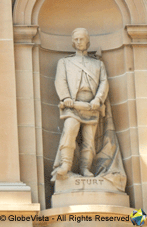Charles Sturt statue

Public Art: Charles Sturt statue
Sculptor: ©
Description: The sandstone carving of Charles Sturt, explorer, is one of 24 sandstone carved figures on the ledges of the Land Department Building.
Date Unveiled: c1891
Location: The Statue of Captain Charles Sturt is located in a niche on the Bridge Street facade of the Department of Lands Building, Bridge Street, Sydney, Australia.
So who was Charles Sturt? : Captain Charles Napier Sturt (28th April 1795 – 16th June 1869) was a British explorer who led several expeditions into the interior of Australia in search of an “inland sea”.
Charles Sturt was born in Bengal, India, the firstborn of thirteen children. His father was a judge assigned to India under the British East India Company. At the age of five, Charles returned to England and lived with his relatives whilst attending school. At 15 he attended Harrow but due to family financial difficulties he ensigned in the British Army rather than enter Cambridge University.
In 1827, having been promoted to Captain, Sturt set sail for New South Wales, escorting convicts on the ship Mariner. The then governor of NSW, Sir Ralph Darling, was quite impressed with Sturt and offered him the role of major of brigade and military secretary. His new role saw him mingling with the likes of John Oxley, Allan Cunningham, Hamilton Hume, and other explorers, which ignited an interest in the exploration of the interior of the country.
Sturt proposed an expedition to explore further up the Macquarie River, around the western area of NSW in search of an inland sea and in 1828 it was approved. During this expedition, which included Charles Sturt, Hamilton Hume, two soldiers and 8 convicts, the group explored the Macquarie, Bogan and Castlereagh rivers and discovered the Darling River. Despite the expedition proving that northern NSW had no inland sea they were none the wiser as to where the western-flowing rivers of New South Wales went.
As you would expect, Sturt proposed another expedition to solve the “inland sea” mystery. This time the expedition was to travel down the Murrumbidgee River. George Macleay replaced Hume. The group set off in 1830 carrying with them a dismantled whaleboat that they assembled when they reached the Murrumbidgee River. On the journey, the Murrumbidgee joined up with a much larger river which Sturt named Murray. This river eventually met up with the Darling, proving that all the western-flowing rivers eventually flowed into the Murray.
The group then followed the Murray to its mouth and discovered with great disappointment it was impassable to ships, thanks to all the lagoons and sandbars. Now the group had the horrendous task of rowing back up the Murray and Murrumbidgee Rivers (against the currents) in the heat of the Australian summer to return back to Sydney. This was no mean feat and it wasn’t long before food supplies got perilously low. Sturt ordered two men to cross overland to find food and water. Fortunately they returned just in time to save the team from certain starvation, however, the journey nearly cost Sturt his eyesight. For the rest of his life Sturt would suffer poor eyesight.
In 1833 Sturt, having returned to England due to ill health, published his first book Two Expeditions into the Interior of Southern Australia during the years 1828, 1829, 1830 and 1831. Despite requests for Sturt’s promotion nothing came of it and instead he was granted 5,000 acres (2,000 ha) of land in Australia in exchange for giving up his pension rights.
On his return to Australia in 1835 he began farming on his newly acquired land. However his love of exploring never waned and he continued to venture and explore the rivers of South Australia and NSW. During his brief stint as Registrar-General he proposed a major expedition into the interior of Australia in search of that mythical “inland sea”.
In 1844, Sturt and a party of 15 men (including explorer John McDouall Stuart ) set out to explore central Australia. They first travelled up the Murray and Darling Rivers before passing through what would later be called Broken Hill. For several months they had to stay put at Milparinka (near Broken Hill) due to the extreme summer conditions. When the rains came they established a depot at Fort Grey and a smaller party, which included Sturt, pressed on into the Simpson Desert. The weather was again their curse and they returned back to Fort Grey. A second attempt was made to reach the centre of Australia but Sturt contracted scurvy in the horrendous heat and the expedition was abandoned.
In the ensuing years, Sturt bounced back and forth between England and Australia but poor health and the unsuccessful applications for the positions of Governor of Victoria and Governor of Queensland saw him live out his final years in England.